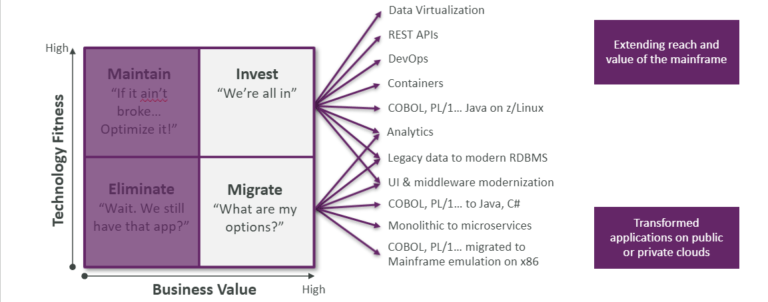Mainframe Modernization: Transformative Solutions for the Mainframe Environment

Linda Graham
Product Marketing Manager, Advisory & Consulting
The term mainframe modernization often means different things to different people. What options are available? What does it take to get there? How long are the timelines? What will my return on investment look like? What partners should I work with?
Organizations have many motivations for embarking on mainframe modernization initiatives. In our experience, we’ve found that these are driven by a wide variety of mainframe strategies, challenges, needs and business drivers.
Modernize With the Latest Mainframe Capabilities
For many organizations, the mainframe remains a critical asset, a work horse that underpins the business-critical applications that drive revenue, customer experience and other key business transactions. These organizations seek opportunities to invest continually into the mainframe environment as they adopt the latest mainframe capabilities such as:
- Modernizing application languages and databases on the mainframe to address declining legacy skills
- Embracing DevOps application development and release processes across the mainframe to increase application development velocity
- Enabling modern methods of mainframe data access and integration for cloud-based systems and application developers
Seeking Cost and Performance Improvements
Like most things, mainframe environments benefit from a continuous focus on efficiency. Driving down mainframe costs and optimizing capacity, performance, software license spending, and security are typical drivers for mainframe modernization. Organizations often engage expert consultants to perform an assessment of their mainframe environments to provide actionable recommendations for improvement and then to implement these proposals and deliver the desired outcomes.
In a growing number of situations, a mainframe skills shortage due to retiring workforces prompts a need to address this particular risk though outsourcing to a service provider or by seeking skills augmentation for the internal team.
Moving Applications to the Cloud
Another significant driver of mainframe modernization conversations is when an organization wishes to pursue a strategy to move applications from the mainframe to a public or private cloud environment. Organizations seek expert guidance and understanding of their options for moving workloads off the mainframe platform, to transform and migrate applications and data to the cloud.
Sometimes a workload is better suited for a cloud platform rather than the mainframe. Sometimes moving some applications to the cloud creates headroom for strategic mainframe applications to grow – perhaps because of increased forecast demand and the desire to avoid a costly upgrade of the mainframe capacity.
Taking a Consultative Approach to Mainframe Modernization
The mainframe consulting team at Ensono works closely with our clients to determine a path forward for mainframe modernization. The graphic provided here illustrates two different approaches that an organization may take in the modernization journey.

Those that fall into the Invest box on the graphic are organizations that are fully committed to investing and using the latest capabilities that the mainframe has to offer. They’re “all in” and are looking for modernization services that enable data virtualization and APIs that front mainframe and off-mainframe datasets, making it easier for developers on non-mainframe platforms to consume critical mainframe datasets in business applications.
Some of these organizations are adopting DevOps processes and tools that can be used across public cloud as well as their mainframe environment. We’ve worked with clients who have all but eliminated COBOL, PL/1 and Assembler and are now using Java on zLinux and container technologies.
Data lies at the heart of any application and many organizations are looking to modernize away from legacy mainframe datasets and technologies such as VSAM, IMS, IDMS to relational database capabilities on the mainframe, often using IBM Db2.
When It’s Time to Migrate
Now, take a look at those in the Migrate box in the graphic. This space represents organizations that are exploring a strategy to move away from the mainframe or are building a business case for transforming and migrating certain applications off the mainframe and moving them to the cloud.
Transformation considerations roughly fall into three categories to consider:
- Automated Application Code and Data conversion uses high levels of proven automation to convert legacy code to modern languages (for example, convert from COBOL, PL/1, Assembler to Java or C#, that will be deployed on a public or private cloud platform). Application conversion approaches and tools have evolved a long way in the past few years and the most modern Business Rules Extraction (BRE) techniques promise the best outcome in terms of a maintainable, modernized application end-state. Data migration goes hand in hand with this conversion process. For instance, it could be a move from IDMS, IMS, VSAM or ADABAS to SQL Server, Postgres, Oracle and others.
- Emulation “lift, tweak and shift,” which does not solve the legacy skills shortage if that is a key modernization driver. Code such as COBOL can be moved to a mainframe emulator software package or “software-defined mainframe” running on x86 hardware, often driven by a desire to reduce platform costs through commodity cloud infrastructure. You still need to ensure high availability, security and disaster recovery, but can achieve them through non-mainframe techniques. Additionally, you will often need to recompile your code and pay for ongoing mainframe software emulation licensing to run the applications. This option is often for those organizations that have an urgent desire to move off the mainframe and wish to contain applications that are likely to be retired over time and hence do not wish to invest in modernizing the application at this time.
- Write new cloud native applications and migrate data as required. Likely the costliest option, but it provides the opportunity to rethink the business application entirely – both from a technical and business point of view – rather than simply duplicate the legacy mainframe application. This path is taken by some organizations seeking to innovate and create new customer experiences and deploy with flexible architectures such as microservices and consumer PaaS elements of public cloud platforms. They then typically retire the mainframe application they were using.
Case Study: Global Insurance Broker and Actuarial Services Provider
This company, a global insurance broker and actuarial services provider, needed to reduce costs by moving its data archive and retrieval application from the mainframe. The organization also required a new application front end to replace the legacy mainframe code as it migrated its data to a reliable, secure, managed and optimized environment in Azure.
Ensono proposed an Application Transformation solution, which featured a consulting project consisting of IDMS data extraction, new C# front-end interface, SQL Server database, Azure deployment, and management of the project end-to-end. We engaged with one of our specialist partners for the code and data transformation portion of the project. We’re currently building a secure Azure environment that will deploy and run the transformed application and database for this client. The client expects a return on investment nine months after the cut-over is completed.
Working with an Experienced Mainframe Modernization Consulting Team
When embarking on a mainframe modernization project, be sure to include both technical and business considerations in the planning process. An excellent way to kick off mainframe modernization is to engage with an experienced partner such as Ensono to help design and deliver your project. Our team takes a consultative approach to better and more deeply understand an organization’s specific challenges, goals, and constraints.
Next, we can perform assessments (both technical and business case) and then propose transformative solutions to help modernize applications on the mainframe, or move applications from the mainframe to cloud.
No matter where clients are in their mainframe modernization journey, we design and deliver the transformational change you need. To learn more, visit https://www.ensono.com/services/advisory-consulting/mainframe-consulting/
Social Share
Don't miss the latest from Ensono
Keep up with Ensono
Innovation never stops, and we support you at every stage. From infrastructure-as-a-service advances to upcoming webinars, explore our news here.
Blog Post | June 3, 2025 | Industry trends
From Data Center Exit to AI-Ready Cloud: Lessons from the Field
Blog Post | April 16, 2025 | Industry trends
Closing the Cloud Skills Gap with Engineering Talent that Flexes with You
Blog Post | April 8, 2025 | Technology trends